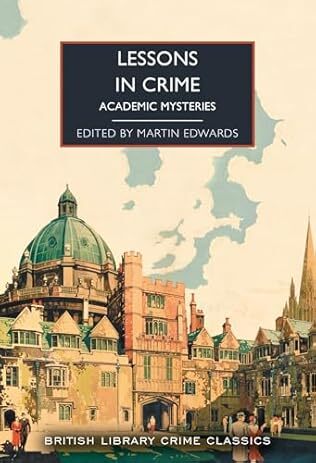Lessons In Crime

A review of Lessons in Crime: Academic Mysteries, edited by Martin Edwards – 2500601
I have always enjoyed the anthologies of short stories around a theme curated by Martin Edwards and issued as part of the British Library Crime Classics series and Lessons in Crime, fifteen stories with university or school as their theme, is no exception. Spanning a century, the earliest, Holmes of course, from 1904 and the most recent from 2000, there is bound to be something to whet the appetite of even the most hard-hearted of crime fiction fans. Of course, as with any anthology it is a bit hit and miss, some stories better than others, and a mix of the familiar and the new.
Opening the batting is HC Bailey’s The Greek Play from 1932 which cleverly uses the plot of Sophocles’ Antigone to set up a contemporary tragedy and a surprising culprit, although Reggie Fortune is more than up to the challenge. When I had vaguely mastered the mysteries of the grammar of Ancient Greek Antigone was the first play I read in full in the original and it has always held more than its fair share of terrors for me. Bailey just added another layer!
The second story also resonated personally with me. My senior school was called The Priory and I have always had a soft spot for Conan Doyle’s The Adventure of the Priory School, even if it is a little too obvious. The obligatory Dorothy L Sayers’ story, Murder at Pentecost, is at least full of whimsy if not Wimsey as the sleuth is Montague Egg, a travelling wine salesman, who is on hand to solve a particularly taxing mystery.
There are a couple of duds. I am not a great fan of Hoffnung’s Raffles and The Field of Philippi , whilst designed to reveal his more sensitive and caring nature, just seems overlong and a tad pointless. The other is Joyce Porter’s Dover Goes To School from 1978. Dover is a boorish character with little to recommend him who has the ability to solve a tricky problem almost in his sleep.
On the plus side there is a wonderful contribution from the vastly underrated Michale Innes, Lesson in Anatomy, which is both clever, nonplussing this reader, and somewhat gruesome. It evoked images that I will remember for some time. I also particularly enjoyed a couple of other stories at the back end of the collection which explored the psychological aspects of the teacher-pupil relationship.
Miriam Sharman’s Battle of Wits is a tense story in which a headmaster who has publicly humiliated a pupil is confronted by an irate parent who is out for revenge, or is he? For a relatively short story, it certainly packs a punch. Children who were different were not treated as sensitively as perhaps they are now and this is a theme Jacqueline Wilson takes up in The Boy Who Couldn’t Read. A battle of wills between a teacher determined to make a point and an obstinate child ends in a surprising but strangely satisfying conclusion.
One of the few stories to explore what children are capable of doing to other children is Colin Watson’s The Harrowing of Henry Pygole, where a prank goes horribly wrong. Any contribution from Edmund Crispin is welcome in my book and the delightfully brief but well-honed Dog in the Night-Time sees Gervase Fen take a leaf out of Sherlock Holmes’ book.
Academic institutions, worlds in their own right within the wider world, breeding grounds for jealousy, thwarted ambition, petty rivalries, and a melting pot of different characters and personality traits, are a perfect breeding ground for crime as this excellent anthology demonstrates.



